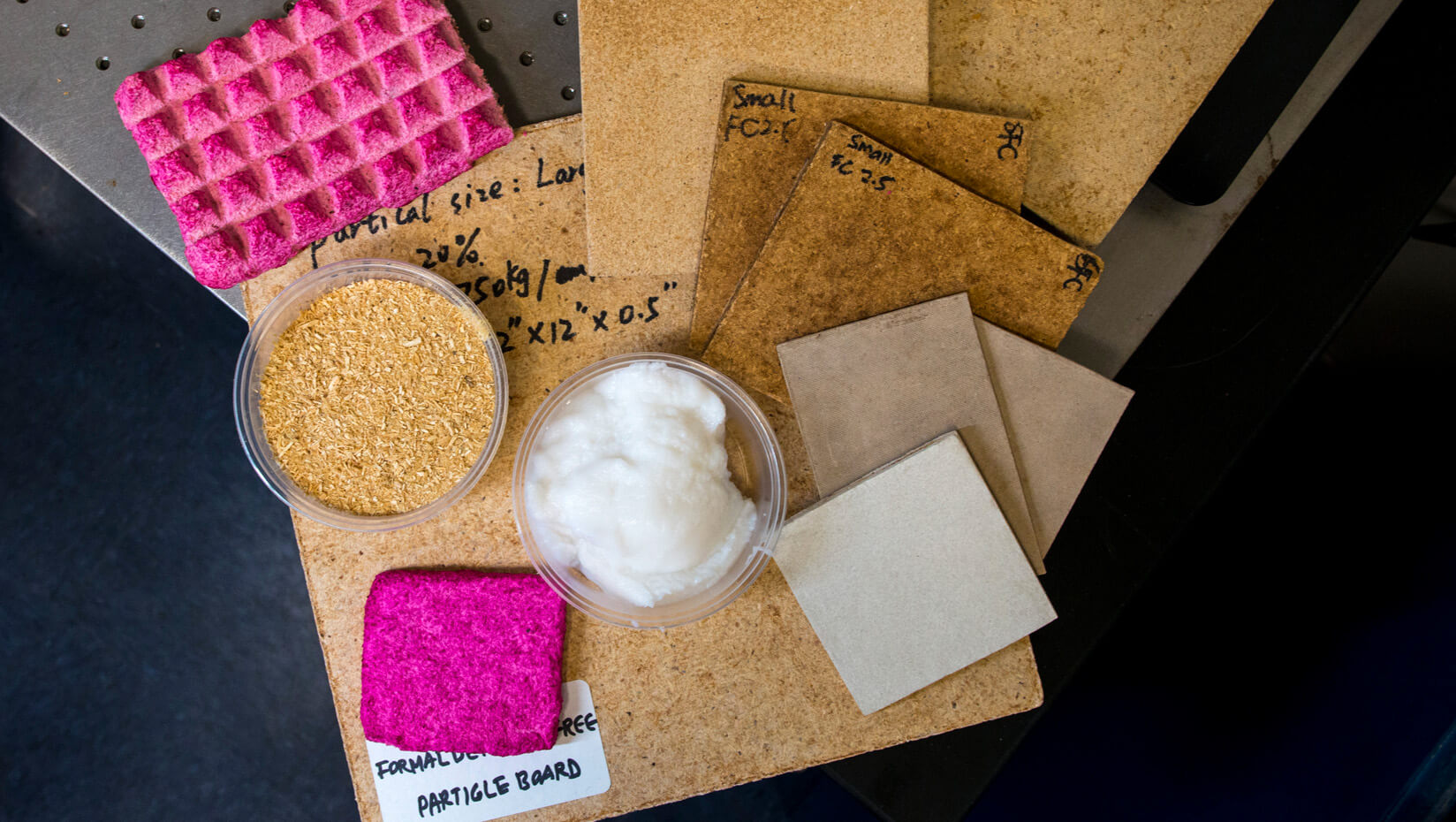
Researchers Awarded $250,000 Grant to Develop Next-Generation CNF Building Materials; Support Growth of Maine Forest Products Industry
Drs. Mehdi Tajvidi, Douglas Gardner, Douglas Bousfield, and Jinwu Wang of the School of Forest Resources and Advanced Structures and Composites Center have received a $250,000 grant from P3Nano to develop next generation cellulose nanofibril (CNF) building materials. The goal of this research is to commercialize new CNF building materials, which would lead the creation of Maine forest industry jobs and improve Maine’s forest health. If successful, Maine mills could be modified to handle large-scale production of these products.
The grant will advance three CNF building materials: a scratch-, fire-, and water-resistant flooring system made of CNF and cement; a lighter and more insulative alternative to traditional plaster drywall made with CNF and wood particles; and a lightweight interior wall covering system that’s easy to mold into various shapes, made in partnership with G-O Logic of Belfast, ME, and FiberLean Technologies.
Dr. Tajvidi Awarded $250,000 to Develop Next-Generation CNF Floor, Wall Products
Tajvidi knows that big things can come in small packages. He works with cellulose nanofibrils (CNF), which are the natural structural building units of wood. CNF are 1/100,000th the width of a human hair.
The University of Maine assistant professor of renewable nanomaterials describes CNF as “magical.” The renewable biodegradable material has superior properties, he says, including exceptional strength and ability to bond.
Tajvidi has been awarded $250,000 from P3Nano to develop next-generation CNF building materials. P3Nano is a public-private partnership founded by the U.S. Endowment for Forestry and Communities and the U.S. Forest Service.
Tajvidi is advancing three materials, the first of which is a scratch-, fire-, and water-resistant flooring system made of CNF and cement. He is collaborating with the Washington state-based company C3 (Ceramic Cement Corporation) to produce the eco-friendly, durable flooring product. C3 produces high-end, fast-curing cement that sticks to wood, and is contributing in-kind materials and expertise to the endeavor.
Tajvidi’s second material has him developing and testing an alternative to traditional drywall made of plaster. His version, which is made with CNF and wood particles, is lighter and a superior insulator. Tajvidi plans to make the material’s core fire resistant as well.
For his third material, he’s partnering with G-O Logic to create a lightweight, interior wall covering system that can be easily molded into various shapes. G-O Logic is a Belfast, Maine firm that makes advanced building products for the high-performance construction market.
FiberLean Technologies, a global producer of FiberLean products that combine CNF and minerals, has contributed $10,000 cash and $10,000 in-kind support toward implementation of the wall-covering product. UMaine researchers Douglas Gardner, Douglas Bousfield, and Jinwu Wang are co-principal investigators on the project.
In June, Tajvidi and several students from UMaine’s Laboratory of Renewable Nanomaterials will take samples and panels of products to the TAPPI Nano 2018 International Conference on Nanotechnology for Renewable Materials in Madison, Wisconsin.
Three years ago, Tajvidi led a UMaine team that was awarded a $350,000 grant by P3Nano to use CNF as an eco-friendly binder for strong particleboard panels. Urea-formaldehyde is used currently as a binder in the panels and the U.S. Environmental Agency has classified formaldehyde as a probable human carcinogen.
Tajvidi says the UMaine team has made significant strides with the project, including learning how to remove water from particleboard panels without using heat. However, challenges still remain. Some of the adhesion and dewatering mechanisms in the process are unknown.
Additionally, while CNF products have considerable market promise, Tajvidi says techniques and methodology need to be optimized. This would allow for the mass production and commercialization of CNF products to be economically feasible.
Tajvidi believes that product commercialization which leads to jobs and improved forest health is an exciting, worthwhile goal.
“Large-volume applications of cellulose nanomaterials such as these are unthinkable without having access to the unparalleled research facilities at the UMaine Composites Center, where most of the scale-up effort will take place,” Tajvidi said.
Tajvidi also stated that Maine mills could be modified to handle production, and added that he has numerous other ideas of how to utilize the magic of CNF in a variety of other products.
